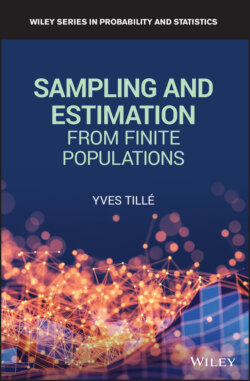Читать книгу Sampling and Estimation from Finite Populations - Yves Tille - Страница 2
Table of Contents
Оглавление1 Cover
2 List of Figures
3 List of Tables
4 List of Algorithms
5 Preface
6 Preface to the First French Edition
7 Table of Notations
8 Chapter 1: A History of Ideas in Survey Sampling Theory 1.1 Introduction 1.2 Enumerative Statistics During the 19th Century 1.3 Controversy on the use of Partial Data 1.4 Development of a Survey Sampling Theory 1.5 The US Elections of 1936 1.6 The Statistical Theory of Survey Sampling 1.7 Modeling the Population 1.8 Attempt to a Synthesis 1.9 Auxiliary Information 1.10 Recent References and Development Notes
9 Chapter 2: Population, Sample, and Estimation 2.1 Population 2.2 Sample 2.3 Inclusion Probabilities 2.4 Parameter Estimation 2.5 Estimation of a Total 2.6 Estimation of a Mean 2.7 Variance of the Total Estimator 2.8 Sampling with Replacement
10 Chapter 3: Simple and Systematic Designs 3.1 Simple Random Sampling without Replacement with Fixed Sample Size 3.2 Bernoulli Sampling 3.3 Simple Random Sampling with Replacement 3.4 Comparison of the Designs with and Without Replacement 3.5 Sampling with Replacement and Retaining Distinct Units 3.6 Inverse Sampling with Replacement 3.7 Estimation of Other Functions of Interest 3.8 Determination of the Sample Size 3.9 Implementation of Simple Random Sampling Designs 3.10 Systematic Sampling with Equal Probabilities 3.11 Entropy for Simple and Systematic Designs
11 Chapter 4: Stratification 4.1 Population and Strata 4.2 Sample, Inclusion Probabilities, and Estimation 4.3 Simple Stratified Designs 4.4 Stratified Design with Proportional Allocation 4.5 Optimal Stratified Design for the Total 4.6 Notes About Optimality in Stratification 4.7 Power Allocation 4.8 Optimality and Cost 4.9 Smallest Sample Size 4.10 Construction of the Strata 4.11 Stratification Under Many Objectives
12 Chapter 5: Sampling with Unequal Probabilities 5.1 Auxiliary Variables and Inclusion Probabilities 5.2 Calculation of the Inclusion Probabilities 5.3 General Remarks 5.4 Sampling with Replacement with Unequal Inclusion Probabilities 5.5 Nonvalidity of the Generalization of the Successive Drawing without Replacement 5.6 Systematic Sampling with Unequal Probabilities 5.7 Deville's Systematic Sampling 5.8 Poisson Sampling 5.9 Maximum Entropy Design 5.10 Rao–Sampford Rejective Procedure 5.11 Order Sampling 5.12 Splitting Method 5.13 Choice of Method 5.14 Variance Approximation 5.15 Variance Estimation Exercises
13 Chapter 6: Balanced Sampling 6.1 Introduction 6.2 Balanced Sampling: Definition 6.3 Balanced Sampling and Linear Programming 6.4 Balanced Sampling by Systematic Sampling 6.5 Methode of Deville, Grosbras, and Roth 6.6 Cube Method 6.7 Variance Approximation 6.8 Variance Estimation 6.9 Special Cases of Balanced Sampling 6.10 Practical Aspects of Balanced Sampling Exercise
14 Chapter 7: Cluster and Two‐stage Sampling 7.1 Cluster Sampling 7.2 Two‐stage Sampling 7.3 Multi‐stage Designs 7.4 Selecting Primary Units with Replacement 7.5 Two‐phase Designs 7.6 Intersection of Two Independent Samples Exercises
15 Chapter 8: Other Topics on Sampling 8.1 Spatial Sampling 8.2 Coordination in Repeated Surveys 8.3 Multiple Survey Frames 8.4 Indirect Sampling 8.5 Capture–Recapture
16 Chapter 9: Estimation with a Quantitative Auxiliary Variable 9.1 The Problem 9.2 Ratio Estimator 9.3 The Difference Estimator 9.4 Estimation by Regression 9.5 The Optimal Regression Estimator 9.6 Discussion of the Three Estimation Methods
17 Chapter 10: Post‐Stratification and Calibration on Marginal Totals 10.1 Introduction 10.2 Post‐Stratification 10.3 The Post‐Stratified Estimator in Simple Designs 10.4 Estimation by Calibration on Marginal Totals 10.5 Example
18 Chapter 11: Multiple Regression Estimation 11.1 Introduction 11.2 Multiple Regression Estimator 11.3 Alternative Forms of the Estimator 11.4 Calibration of the Multiple Regression Estimator 11.5 Variance of the Multiple Regression Estimator 11.6 Choice of Weights 11.7 Special Cases 11.8 Extension to Regression Estimation
19 Chapter 12: Calibration Estimation 12.1 Calibrated Methods 12.2 Distances and Calibration Functions 12.3 Solving Calibration Equations 12.4 Calibrating on Households and Individuals 12.5 Generalized Calibration 12.6 Calibration in Practice 12.7 An Example
20 Chapter 13: Model‐Based approach 13.1 Model Approach 13.2 The Model 13.3 Homoscedastic Constant Model 13.4 Heteroscedastic Model 1 Without Intercept 13.5 Heteroscedastic Model 2 Without Intercept 13.6 Univariate Homoscedastic Linear Model 13.7 Stratified Population 13.8 Simplified Versions of the Optimal Estimator 13.9 Completed Heteroscedasticity Model 13.10 Discussion 13.11 An Approach that is Both Model‐ and Design‐based
21 Chapter 14: Estimation of Complex Parameters 14.1 Estimation of a Function of Totals 14.2 Variance Estimation 14.3 Covariance Estimation 14.4 Implicit Function Estimation 14.5 Cumulative Distribution Function and Quantiles 14.6 Cumulative Income, Lorenz Curve, and Quintile Share Ratio 14.7 Gini Index 14.8 An Example
22 Chapter 15: Variance Estimation by Linearization 15.1 Introduction 15.2 Orders of Magnitude in Probability 15.3 Asymptotic Hypotheses 15.4 Linearization of Functions of Interest 15.5 Linearization by Steps 15.6 Linearization of an Implicit Function of Interest 15.7 Influence Function Approach 15.8 Binder's Cookbook Approach 15.9 Demnati and Rao Approach 15.10 Linearization by the Sample Indicator Variables 15.11 Discussion on Variance Estimation
23 Chapter 16: Treatment of Nonresponse 16.1 Sources of Error 16.2 Coverage Errors 16.3 Different Types of Nonresponse 16.4 Nonresponse Modeling 16.5 Treating Nonresponse by Reweighting 16.6 Imputation 16.7 Variance Estimation with Nonresponse
24 Chapter 17: Summary Solutions to the Exercises
25 Bibliography
26 Author Index
27 Subject Index
28 End User License Agreement
